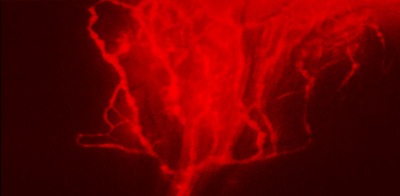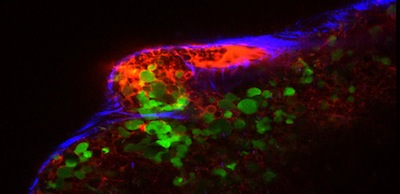Solid Stress
Although, lymphatic vessels are responsible for both draining interstitial fluid from tissues and for transporting immune cells to lymph nodes to maintain the body’s immune surveillance, the focus of our research in the Steele Laboratory is on the fluid balance aspect of lymphatic function. We use fluorescence microlymphangiography to identify functional lymphatic vessels in vivo (Cite Leu 1992 and Hoshida 2006).

(Tail lymphatic with MPSLM)

(Ear lymphatic w/ bv)
Once identified, we can evaluate the how well the lymphatic transport lymph using Residence Time Distribution Analysis (Cite Swartz 1996) or Fluorescence Photobleaching (Berk 1996). Residence Time Distribution Analysis determines the flow in the lymphatic network as a whole.
Fluoresence Photobleaching determines the flow in individual lymphatic vessels.

(Tohru’s or Berk’s paper)
In addition to the amount of flow, the direction of lymph flow can also be evaluated using the dorsal skinfold chamber.
In tumors, there seems to be a lack of functional lymphatic vessels (Cite Padera 2002). This results in an elevated fluid pressure in tumors, forming a critical barrier to the homogeneous distribution of drugs throughout the tumor (Cite Jain 2007). We have measure fluid pressure in hundreds of tumors in patients and have found it consistently elevated over normal tissue levels (Cite Jain 1994 SA). How novel targeted therapies affect tumor interstitial fluid pressure is being explored as part of our Clinical Trials.
